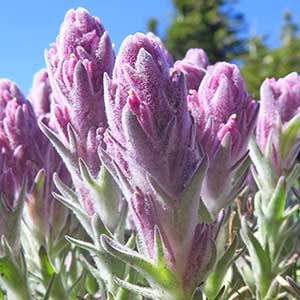|
split hair Indian paintbrush, split-hair paintbrush
|
| Herbs, perennial, 0.8–1.5 dm; from a woody caudex; with a taproot. |
few to many, ascending to erect, unbranched, hairs dense, appressed-ascending, matted, long, soft, branched, eglandular, ± white-woolly, obscuring surface. |
gray-green with hairs, surface green to purple, linear-lanceolate, 0.5–2 cm, not fleshy, margins plane, ± involute, 0(–3)-lobed, apex acute to acuminate, sometimes rounded; lobes sometimes divergent, spreading-ascending, narrowly linear, apex acute. |
3–8 × 1–2 cm; bracts purple, lavender, pinkish, or dusty red throughout, sometimes greenish throughout or proximally greenish, distally colored as above, obscured by hairs, lanceolate, 3(–5)-lobed; lobes ascending to erect, linear to oblanceolate, short, arising near or above mid length, apex obtuse. |
straight, 15–20 mm; tube 8–9 mm; beak included to slightly exserted, adaxially purple or pink, 3.9–5 mm, densely puberulent with white, woolly hairs; abaxial lip deep purple, inconspicuous, pouched, pouches shallow, 3–5 mm, 80–100% as long as beak; teeth upright-ascending, reduced, appearing white, 1.5–2 mm. |
colored as bracts, 11–18 mm; abaxial and adaxial clefts 3.5–6 mm, 33–50% of calyx length, all 4 clefts subequal, lateral 4–6 mm, 33–50% of calyx length; lobes linear, apex acute. |
|
|
|
| Flowering Jul–Aug. |
| Meadows, ledges, rocky or gravelly slopes, subalpine to alpine, marble, granite, or serpentine substrates. |
| 1600–2600 m. (5200–8500 ft.) |
|
CA; OR
|
Castilleja schizotricha is a rare species restricted to high elevations in the mountains in Siskiyou and Trinity counties in northwestern California and in Jackson and western Klamath counties in southwestern Oregon. See the discussion of 6. C. arachnoidea for morphological differences between it and C. schizotricha, as the two are sometimes confused. Though their ranges overlap, they do not appear to hybridize. (Discussion copyrighted by Flora of North America; reprinted with permission.) |
| FNA vol. 17, p. 655. |
| Orobanchaceae > Castilleja |
C. affinis, C. ambigua, C. angustifolia, C. applegatei, C. aquariensis, C. arachnoidea, C. attenuata, C. brevilobata, C. brevistyla, C. campestris, C. cervina, C. chambersii, C. chlorotica, C. christii, C. chromosa, C. chrymactis, C. chrysantha, C. cinerea, C. citrina, C. coccinea, C. collegiorum, C. covilleana, C. crista-galli, C. cryptantha, C. cusickii, C. densiflora, C. dissitiflora, C. disticha, C. elata, C. elegans, C. elmeri, C. exserta, C. flava, C. foliolosa, C. fraterna, C. genevieveana, C. glandulifera, C. gleasoni, C. gracillima, C. grisea, C. haydenii, C. hispida, C. hololeuca, C. hyperborea, C. indivisa, C. integra, C. kaibabensis, C. kerryana, C. kraliana, C. lacera, C. lanata, C. lasiorhyncha, C. lassenensis, C. latifolia, C. lemmonii, C. leschkeana, C. levisecta, C. linariifolia, C. lindheimeri, C. lineariloba, C. lineata, C. litoralis, C. lutescens, C. martini, C. mendocinensis, C. mexicana, C. miniata, C. minor, C. mogollonica, C. mollis, C. montigena, C. nana, C. nelsonii, C. nervata, C. nivea, C. occidentalis, C. oresbia, C. organorum, C. ornata, C. pallescens, C. pallida, C. parviflora, C. parvula, C. patriotica, C. peckiana, C. peirsonii, C. pilosa, C. plagiotoma, C. praeterita, C. pruinosa, C. puberula, C. pulchella, C. purpurascens, C. purpurea, C. raupii, C. revealii, C. rhexiifolia, C. rigida, C. rubicundula, C. rubida, C. rupicola, C. salsuginosa, C. scabrida, C. septentrionalis, C. sessiliflora, C. subinclusa, C. suksdorfii, C. tenuiflora, C. tenuis, C. thompsonii, C. tomentosa, C. uliginosa, C. unalaschcensis, C. victoriae, C. viscidula, C. wightii, C. wootonii, C. xanthotricha |
| C. arachnoidea subsp. schizotricha |
| Greenman: Bot. Gaz. 53: 511. (1912) |
|


